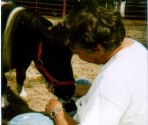The normal vaccinations and their frequency...
MANAGEMENT TOPICS OF THE SEASON
Vaccinations and Frequency: how many, what for, how often
In this "Management Topics of the Season" series, we will first discuss topics that apply to the using horse this time of the year, and then spend some time with the brood mare. If you have had your horses on a vaccination and deworming program, just watching for reminders in the mail is all you have to do.
For the new horse or one not previously under a veterinarianís care, you will want it vaccinated for the respiratory diseases. These are primarily rhinopneumonitis, influenza, and strangles. The first two are due to viruses and both cause similar symptoms. Dobbin will be feverish, off his feed, and obviously drooping around like we do when we are feverish or off our feed (although I donít think I know what that is). He may be coughing and may have a nasal discharge that is usually clear in the early stages of the disease. The cough frequently persists for days, and without adequate rest for a speedy recovery, may continue for weeks.
Strangles is a bacterial disease, as opposed to a viral disease. It also makes the horse very sick due to the high fever and involvement of the lymph glands. The glands easiest to see when swollen are those in the throat. There may be a nasal discharge which is cloudy or white once the disease has progressed long enough to start causing the glands to abscess.
The above is a very brief description of the more common diseases of the respiratory tract and those most easily transmitted between horses. As brief as I have been, it is still easy to see why we should try to prevent our horses from becoming infected. While the chance of the horses dying is not great, the recovery time can be very long. We are not able to enjoy using them while they are recovering as well as the disagreeable experience of watching them ail. Being herding animals, horses do not hesitate to share their diseases, so the herd mates are also at risk of becoming sick. The only experience worse than nursing one horse is to visit a barn full of coughing horses with nasal discharges!
Fortunately vaccination against the above diseases will afford good protection if done frequently enough. For most riding conditions, twice yearly vaccinations will keep the immunity high enough to prevent the disease when the horse is exposed. In a training situation or on a busy show circuit, quarterly or even bi-monthly vaccinations can be reasonable.
The above vaccinations are against the more common diseases, and the more common stains of the viruses causing these diseases:
By stimulating the horseís immunity to guard against known viruses and bacteria, Dobbin's disease fighting cells will be on the alert and ready to respond more quickly. This should shorten the course of the new infection by reducing its severity.
Other vaccinations the horse needs are:
The first two need only annual boosters after the initial two biweekly injections. The tetanus vaccination may need to be boostered if a severe injury opens the skin and contaminates the underlying tissue. The necessity for a tetanus booster will be determined when the injury is evaluated.
And finally, one rabies vaccination at yearly intervals provides the best protection.
CLICK BELOW TO DISPLAY A PRINTER-FRIENDLY COPY OF THIS ARTICLE
Select "Open this file from its current location," if you just want to print it out,
it will open in a simple word processing application, select the print button.
(unless you want to save this article in your computer's memory)

 VaccinationsHowManyWhatForHowOften.rtf
VaccinationsHowManyWhatForHowOften.rtf